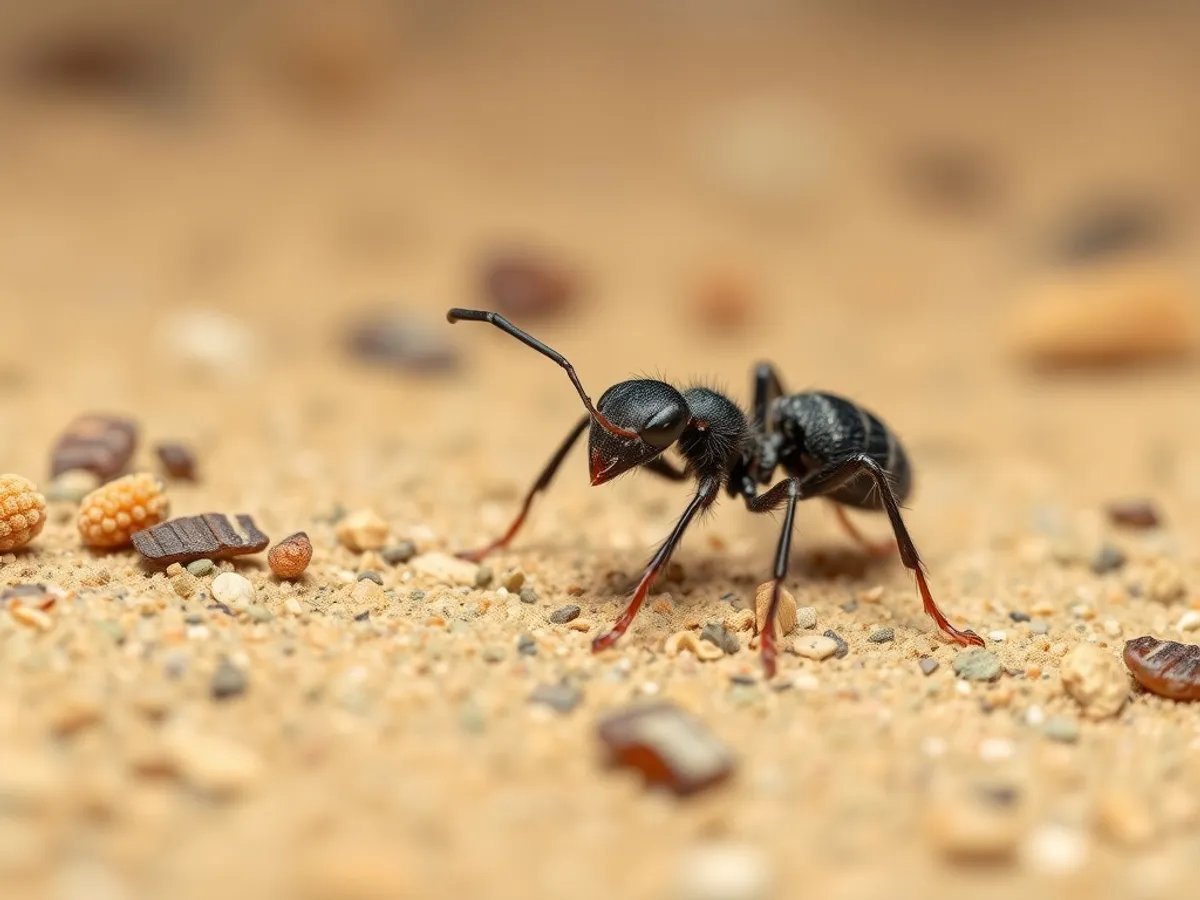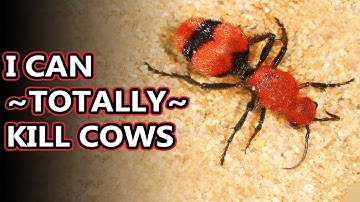
Velvet Ant
Dasymutilla occidentalis

Meet the Velvet Ant
The Velvet Ant, despite its name, is actually a species of solitary wasp known for its dense, brightly colored, velvety hair and powerful sting. Females are wingless and resemble large, hairy ants, while males possess wings and are less often seen. Found primarily in sandy and open habitats, velvet ants are notable for their striking coloration, which serves as a warning to predators. Their larvae are parasitoids, developing by feeding on the larvae of ground-nesting bees and wasps. Velvet ants are resilient insects with a tough exoskeleton and are sometimes called 'cow killers' due to the intensity of their sting, though the name is an exaggeration.
Classification
Invertebrate
Habitat
Dry, sandy areas, open fields, and meadows
Diet
Carnivore
Lifespan
1-2 years
Conservation
Least Concern
Weight
0.02 - 0.05 grams
📖Fascinating Facts
Ant in Name Only
Despite being called 'velvet ants,' these insects are actually wasps and not ants at all.
Painful Sting
The sting of a female velvet ant ranks among the most painful of any North American insect and has earned them the nickname 'cow killer.'
Aposematic Coloration
Their bright red, orange, or yellow coloring serves as a warning signal to predators that they are dangerous and not worth eating.
📋Detailed Description
Dasymutilla occidentalis, commonly known as the 'Eastern Velvet Ant' or 'Cow Killer,' is a large, solitary wasp species notable for its sexual dimorphism. Females are wingless, measuring 18–22 mm in length, and are covered in dense, velvety hair that is bright red-orange with contrasting black bands, serving as a warning (aposematic) coloration. Males are slightly smaller, possess two pairs of transparent wings, and are less conspicuously colored. The exoskeleton of both sexes is exceptionally tough, providing resistance to predation and desiccation. The head is equipped with strong mandibles, and females have a long, flexible stinger that can deliver an intensely painful sting. Velvet ants are primarily diurnal and are most active during the warm months, especially in late spring and summer. Their legs are robust and adapted for rapid movement across sandy or loose soils. Unlike social wasps, D. occidentalis is entirely solitary, with no colonies or cooperative brood care. The species is distributed throughout the eastern and southern United States, favoring dry, open habitats such as fields, pastures, and sandy woodlands. Their lifecycle is closely tied to ground-nesting bees and wasps, whose nests serve as hosts for their parasitic larvae.
💡 Did you know?
Velvet ants can produce a squeaking sound by rubbing body segments together, a behavior known as stridulation.
🔬Research & Sources
Wikipedia Summary
Velvet ants (Mutillidae) are a family of more than 7,000 species of wasps whose wingless females resemble large, hairy ants. Their common name velvet ant refers to their resemblance to an ant, and their dense pile of hair, which most often is bright scarlet or orange, but may also be black, white, silver, or gold. Their bright colors serve as aposematic signals. They are known for their extremely painful stings,, and has resulted in the common name "cow killer" or "cow ant" being applied to the species Dasymutilla occidentalis. However, mutillids are not aggressive and sting only in defense. In addition, the actual toxicity of their venom is much lower than that of honey bees or harvester ants. Unlike true ants, they are solitary, and lack complex social systems.
Last Modified: 11/27/2024
🎭Behavior & Social Structure
Velvet ants are solitary and highly mobile, with females actively searching for the nests of ground-nesting bees and wasps to parasitize. They exhibit a distinctive, erratic walking pattern, often pausing to drum their antennae on the ground, likely to detect chemical cues from host nests. Adults feed primarily on nectar and occasionally on water or honeydew, but do not hunt or consume other insects directly. Females are aggressive when threatened, raising their abdomen and producing a squeaking sound (stridulation) as a warning before stinging. Males, being winged, are more often seen flying low over vegetation in search of mates. Both sexes are primarily crepuscular to diurnal, avoiding activity during the hottest part of the day. There is no social interaction beyond mating, and individuals are territorial, avoiding conspecifics except for reproduction.
👶Reproduction & Life Cycle
Mating occurs during the summer months, with males locating females by scent. After mating, females seek out suitable host nests, typically those of large ground-nesting bees (such as Anthophora or Apidae) or wasps (Sphecidae, Vespidae). The female enters the nest, lays a single egg on or near the host larva or pupa, and departs. The velvet ant larva hatches and consumes the host larva, eventually pupating within the host cell. Development from egg to adult can take several weeks, with one generation per year (univoltine) being typical in temperate regions. There is no parental care beyond egg-laying, and females do not provision or guard their offspring.
🛡️Adaptations & Survival
Dasymutilla occidentalis exhibits several notable adaptations: (1) Aposematic coloration warns predators of its potent sting, reducing predation risk. (2) The exoskeleton is among the hardest of any insect, providing defense against crushing and desiccation. (3) The sting is long, flexible, and capable of penetrating thick skin, serving as both a defense and a deterrent. (4) Females produce stridulatory sounds by rubbing abdominal segments, which serve as an additional warning signal. (5) Their ability to metabolize nectar allows adults to survive in arid habitats with limited prey. (6) The parasitic larval stage enables exploitation of the resources of other Hymenoptera, reducing the need to construct or provision their own nests.
📚Research Sources
🎨Cultural Significance
The velvet ant's painful sting has made it a subject of folklore and rural legend, with the name 'cow killer' reflecting exaggerated beliefs about its potency. In some regions, children are warned to avoid the insect, and it is sometimes featured in local stories as a symbol of pain or resilience. There are no known traditional medicinal or practical uses for this species, but it is occasionally collected by entomologists and naturalists for educational purposes. Its striking appearance and defensive behaviors have made it a popular subject in natural history displays and insect collections.
🔬Recent Research & Discoveries
Recent research has focused on the biomechanics of the velvet ant's exoskeleton, revealing that it is among the most crush-resistant of any insect, likely an adaptation to predation by vertebrates such as birds or small mammals. Studies on venom composition indicate that, while the sting is extremely painful, the actual toxicity is relatively low compared to other Hymenoptera. Ongoing research is examining the chemical ecology of host location, including the role of pheromones and nest odors in guiding females to suitable hosts. The evolution of aposematism and mimicry in the Mutillidae family is also an active area of study, with D. occidentalis serving as a model organism for understanding warning coloration and predator-prey interactions.
🎥Wildlife Videos

David Attenborough Presents: Ant Mountain | Free Documentary Nature
David Attenborough's Ant Mountain | Wildlife Documentary Watch 'David Attenborough presents: Wild City Singapore' here: ...
Free Documentary - Nature

Killer Ants of Amazon Forest- Wildlife Documentary
This documentary is about the unknown social lives of the army ants. Known as the most feared animals in the equatorial forests ...
Living Attractions

Red Velvet Ant facts: they're not actually ants for starters... | Animal Fact Files
On this episode of Animal Fact Files discover a wasp with a confusing name who could supposedly kill a cow. ✨ Animal Fact Files ...
Animal Fact Files

Empire of the Ants 2020 BBC Documentary HD
David Attenborough is in the Swiss Jura Mountains to discover the secrets of a giant. Beneath his feet lies a vast network of ...
Mikey Ant Man

Velvet Ant The Most Beautiful but Painful Insect in the World!
Discover the deadly beauty of the velvet ant – also known as the 'Cow Killer'! In this video, we explore one of the most fascinating ...
Animal World

STUNG by a COW KILLER VELVET ANT
You all asked, I delivered… sort of! Once again we had an adverse result to our sting test! Velvet ants, or cow killers, are flightless ...
Jack’s World of Wildlife
🌍Habitat Information
The Velvet Ant typically inhabits Dry, sandy areas, open fields, and meadows environments. Velvet Ants have adapted to their environments with specialized features and behaviors.
Primary Habitat:
Dry, sandy areas, open fields, and meadows
More detailed habitat information will be available soon.
🛡️Conservation Status
The Velvet Ant is currently classified as Least Concern. Conservation efforts are crucial for preserving this species for future generations.
Common Threats:
- 🏠Habitat loss and fragmentation
- 🌡️Climate change impacts
- 🎯Hunting and poaching
- 🏭Human-wildlife conflict
⚠️Threats & Conservation Challenges
Currently, Dasymutilla occidentalis is not considered threatened and is classified as 'Least Concern.' Its wide distribution and adaptability to disturbed habitats contribute to its stable populations. However, local declines may occur due to habitat loss from urbanization, intensive agriculture, and pesticide use, which reduce the abundance of host species. Climate change may also alter the distribution of both velvet ants and their hosts. There is little targeted conservation effort for this species, but preservation of native pollinator habitats indirectly benefits their populations.
🔬Scientific Classification
Scientific Name
Dasymutilla occidentalis
Classification Hierarchy
🔍 About Taxonomic Classification
Taxonomic classification is a hierarchical system used by scientists to classify and organize living organisms based on shared characteristics and evolutionary relationships.
The system moves from broad categories (Kingdom) to increasingly specific ones, with each animal's scientific name typically consisting of its Genus and species.
📝Community Notes
Share your observations and insights about the Velvet Ant with our community of wildlife enthusiasts.
Join Our Community
Sign in to share your observations and connect with fellow wildlife enthusiasts.
Sign In to ContributeNo community notes yet
Be the first to share your observations about the Velvet Ant!
Explore Velvet Ant
Select a tab above to learn more about this amazing animal.
📸Photo Gallery
No photos available for this animal yet.
🌟Discover More Wildlife
Continue your journey of discovery with more fascinating animals from our database
